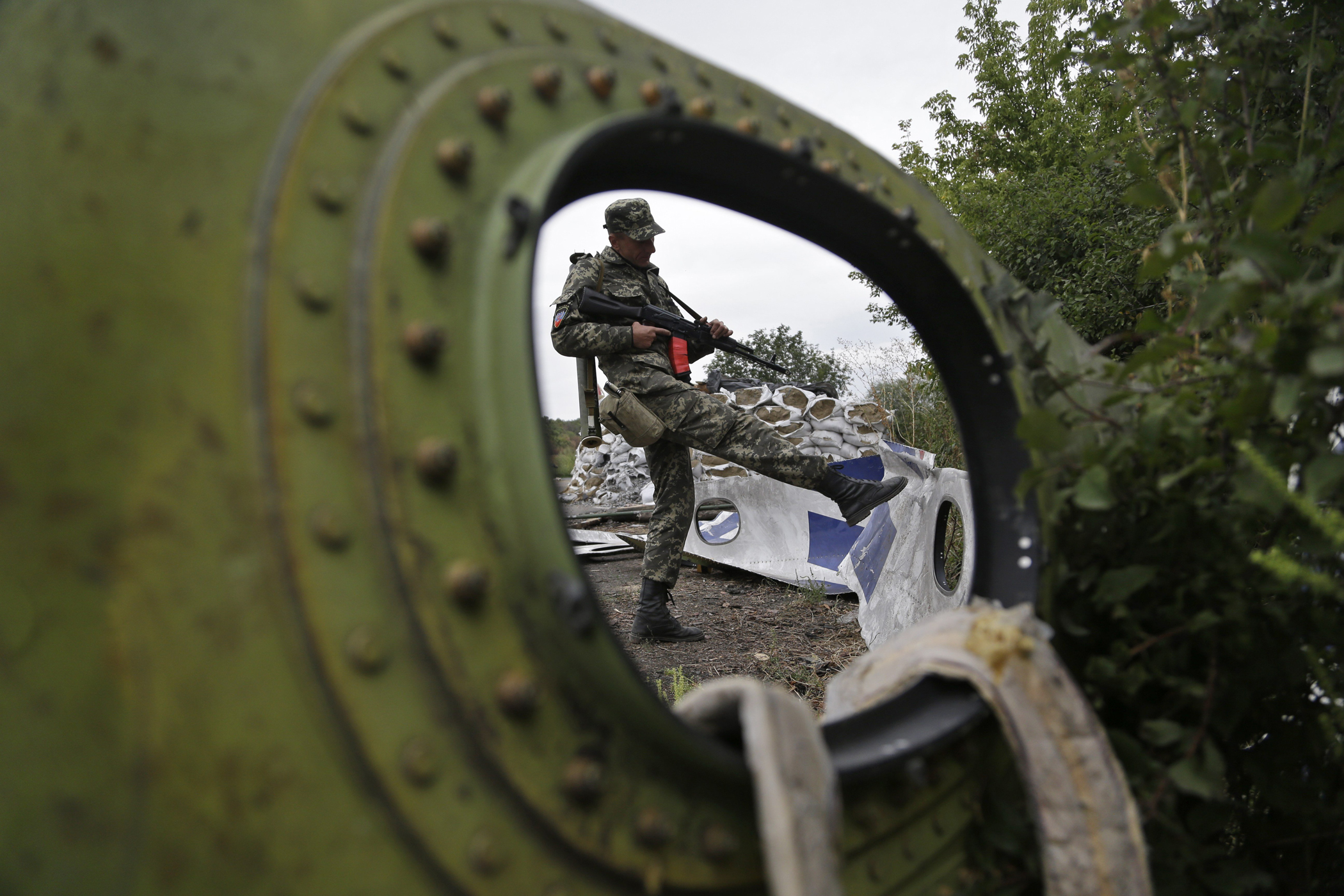
The callous disregard for the wreckage of the Malaysia Airlines flight shot down over eastern Ukraine on July 17 would have been clear to anyone who visited the crash site. By the time foreign investigators were able to access the scene of this crime, it had not just been contaminated; it had been picked apart like a macabre giveaway on the lawn of a foreclosed house.
Chunks of the fuselage were stacked in a pile at a separatist checkpoint near the village of Rassypnoye, just a few miles from the main crash site, seemingly intended to reinforce the rebel barricade of sandbags and concrete that stood just a few steps away. Gawkers from nearby villages climbed atop the vertical tail of the plane, which had landed in a field of wheat, and took photographs like tourists. Locals and rebel fighters were free to take souvenirs from among the wreckage or from the scattered belongings of the 298 people, most of them Dutch citizens, who died in the catastrophe. So it was little wonder on Tuesday that the preliminary report on the causes of the crash was largely inconclusive.
According to the crucial part of the report from the Dutch Safety Board, “The pattern of damage observed in the forward fuselage and cockpit section of the aircraft was consistent with the damage that would be expected from a large number of high-energy objects that penetrated the aircraft from the outside.” This could be consistent with the West’s prevailing theory of what brought down the plane, namely a BUK surface-to-air missile launched by the pro-Russian separatists over the territory they control. Some versions of the payload mounted on a BUK missile can explode on impact with the target or just before, causing pieces of shrapnel — “high-energy objects,” in the words of the report — to shred the fuselage.
But the wording of the 34-page report [in pdf format here] was also vague enough to leave room for one of the more common theories among the rebel fighters in eastern Ukraine. Russian President Vladimir Putin blamed the disaster on the Ukrainian government on the night of the crash; and in the days that followed, some of the separatists claimed in interviews with TIME that a Ukrainian fighter jet had, for some reason, intercepted the airliner and sprayed it with chain-gun fire. As evidence, they pointed to the many small holes in the fuselage, suggesting that these looked like the work of a machine gun shooting another type of high-energy object — bullets.
This hypothesis, a favorite on Russian state television, does not fit well with the audio recordings taken from the cockpit of the plane. According to the Dutch Safety Board, the recording ended abruptly, with no sign that the plane was hit with gunfire or that the pilots had any warning of an approaching missile. Yet the report also makes no mention of any missiles or missile fragments found at the crash site.
That kind of solid evidence — such as a chunk of a projectile with a serial number or chemical signature that could identify its source — could easily have been removed from the crash site by the time investigators arrived. Pro-Russian rebels have had control of the area ever since the plane went down, and in late July, when forensic experts from the Netherlands, Australia and Malaysia were allowed to inspect the wreckage, it was only at the whim of the rebel commanders.
“If we can’t negotiate our entrance, we’re stuck,” the Dutch commander of the search operation, Colonel Cornelis Kuijs, told TIME on Aug. 4, at the mission’s base of operations in eastern Ukraine. “We have no freedom of movement whatsoever.” Two days later, Dutch Prime Minister Mark Rutte suspended the search operation, citing concerns for the safety of the police officers and experts involved.
With much less gear and no police escorts, journalists around the crash site generally faced fewer roadblocks from the rebels, and a BBC investigation seems to have turned up a curious lead. In a program aired Monday on the channel’s Panorama program, a reporter interviewed an alleged witness who claimed to have spoken with one of the fighters who launched the fatal missile. The soldier’s accent, the witness told the BBC, was distinctly Russian, not Ukrainian, leading the witness to believe that the culprit may have been a Russian soldier.
But this does not seem like the kind of evidence that would hold up in a court of law, nor even the court of public opinion. Many Russian citizens have joined the separatist militias fighting in eastern Ukraine, and they are usually military veterans with various types of weapons training. So the presence of a Russian accent would not necessarily prove that a fighter was a Russian soldier. It would merely be another detail to add to the piles of evidence supporting one theory or another. But as seems clear from the pile of wreckage stacked up near that checkpoint in early August, the truth about Flight MH 17 will likely remain elusive, even after investigators publish their final report next year. If there was a smoking gun to be found at the crash site, the rebels had every opportunity to quietly snuff it out.
Tjibbe Joustra, chairman of the Dutch Safety Board, clarifies that the MH 17 report does not use the word missile.
More Must-Reads From TIME
- Dua Lipa Manifested All of This
- Exclusive: Google Workers Revolt Over $1.2 Billion Contract With Israel
- Stop Looking for Your Forever Home
- The Sympathizer Counters 50 Years of Hollywood Vietnam War Narratives
- The Bliss of Seeing the Eclipse From Cleveland
- Hormonal Birth Control Doesn’t Deserve Its Bad Reputation
- The Best TV Shows to Watch on Peacock
- Want Weekly Recs on What to Watch, Read, and More? Sign Up for Worth Your Time
Contact us at letters@time.com